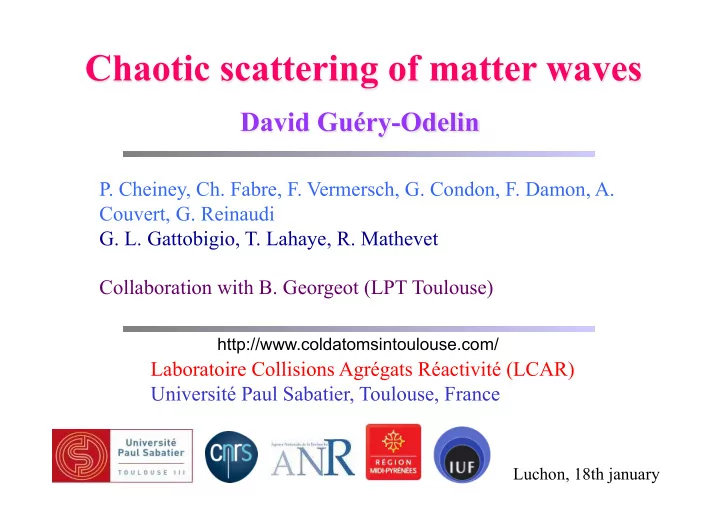

P. Cheiney, Ch. Fabre, F. Vermersch, G. Condon, F. Damon, A. Couvert, G. Reinaudi G. L. Gattobigio, T. Lahaye, R. Mathevet Collaboration with B. Georgeot (LPT Toulouse) http://www.coldatomsintoulouse.com/ Laboratoire Collisions Agrégats Réactivité (LCAR) Université Paul Sabatier, Toulouse, France Luchon, 18th january
Launching a Bose-Einstein condensate in an optical guide Guided atom laser (outcoupled from a trapped Bose-Einstein condensate) This method gives access to the « trajectory »
a b a b a b a b n 1 n 2 n 1 n 2 n 1 n 2 n 1 n 2 Bragg interference condition Stop band Reflection > 99,99 % _ Is it possible to develop « dieletric » atom optics elements? Iacopo Carusotto – Luis Santos (1998- 2002)
Mathieu equation A B A : dominated by quantum reflection, small penetrability B : large penetrability
Red : allowed; blue : forbidden lattice spacing
Red : transmitted ; blue : reflected U 0 ¡ Before After Before After
U 0 ¡ The response of the system contains a fingerprint of the band structure of the lattice
Experiment: example of result Propagation direction
Experiment Numerical simulation Ch. Fabre et al. PRL 107 , 230401 (2011)
v ¡ The envelope « projects » the band gap in position space Spatial gaps
A Landau Zener transition projected in position space corresponds to a tunnel event through the barrier provided by the local band gap. Simulation P. Cheiney et al. EPL 103 , 50006 (2013)
(a) V ( x, y ) y x 2 2 (b) (c) 1.5 1.5 1 1 0.5 0.5 y/w 0 0 -0.5 -0.5 -1 -1 -1.5 -1.5 -2 -2 2 2 -2 -1.5 -1 -0.5 0 0.5 1 1.5 2 -2 -1.5 -1 -0.5 0 0.5 1 1.5 2 (d) (e) 1.5 1.5 1 1 0.5 0.5 y/w 0 0 -0.5 -0.5 -1 -1 -1.5 -1.5 -2 -2 -2 -1.5 -1 -0.5 0 0.5 1 1.5 2 -2 -1.5 -1 -0.5 0 0.5 1 1.5 2 x/w x/w F. Damon in preparation
Evolution of the wavepacket Band structure diagram in position space time x ( µ m) time x ( µ m)
v 0 = 11.25 mm.s -1 Δ v = 6 mm.s -1 U 0 =2E R Experiment Simulation P. Cheiney et al. PRA 87 , 013623 (2013)
Weak coupling (between longitudinal and Transverse degrees of freedom) Strong coupling G. L. Gattobigio et al. PRL 107 , 254104 (2011)
25 20 15 10 5 0 [ µ m] 20 40 60 80 100 120
G. L. Gattobigio et al. PRL 107 , 254104 (2011)
PRL 89 , 220402 (2002) PRL 85 , 5483 (2000) PRL 85 , 5543 (2000) Birkl (Hannover) Schmiedmayer (Innsbruk) Pruvost (Orsay)
I 2 /I 1 G. L. Gattobigio et al. PRL 109 , 030403 (2012)
A splitter as a result of a chaotic dynamics The zone overwhich the chaotic behavior takes place decreases with the angle between the two arms of the beam splitter
Confinement : the LAP breaks the mapping between classical and quantum predictions since the harmonicity of the guide is destroyed by the LAP 1) Tunnel effect (small size defect) 2) Diffraction 3) Interference (long time)
Guide + a lattice at 45° degrees Influence of the confinement (numerical results) remains in the overlap region Classic Classic Quantum Quantum Density of atoms that
y x 2 2 (b) (c) 1.5 1.5 1 1 0.5 0.5 y/w 0 0 -0.5 -0.5 -1 -1 -1.5 -1.5 -2 2 -2 2 -2 -1.5 -1 -0.5 0 0.5 1 1.5 -2 2 -1.5 -1 -0.5 0 0.5 1 1.5 2 (d) (e) 1.5 1.5 1 1 y/w 0.5 0.5 0 0 -0.5 -0.5 -1 -1 -1.5 -1.5 -2 -2 -2 -1.5 -1 -0.5 0 0.5 1 1.5 2 -2 -1.5 -1 -0.5 0 0.5 1 1.5 2 x/w x/w -> development of guided atom optics 2D emergence of chaotic behavior, -> design new kind of tunnel barriers assisted by chaos, influence of the 1D realization of a Bragg mirror, of a Bragg cavity, selective filter confinement on the scattering realization of a beam splitter -> new system in which one can by shaping the lattice envelope by amplitude modulation study quantum chaos
Recommend
More recommend